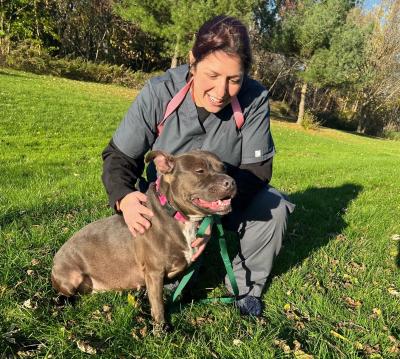Training and the Grading System in Your Dog’s Head
January is Dog Training Awareness Month, so we’re picking the brain of one of our amazing trainers and sharing some of her insights with you. Meet Dana Polsinelli, behavior and enrichment coordinator and one of three certified trainers on our staff.
According to Dana, training is not just about good manners. It’s an activity that strengthens and enriches the bond between people and their pups and boosts canine confidence.
“Dogs are like us. They like a feeling of accomplishment. As humans, we feel good when we can check things off our to-do lists. For dogs, the positive reinforcement they receive gives them a feeling of success and confidence,” says Dana.”

Behavior and Enrichment Coordinator Dana Polsinelli with star pupil, Dutchess.
When we’re teaching dogs good manners, working to modify a behavior, playing games or teaching tricks, it’s mentally stimulating and can be fun. Dogs love to learn and are eager to please. We have to remember, though, that what they do – some of the things we don’t love – are also fun and
natural for them. Digging, chasing and jumping up are all dog behaviors that we seek to change, some for their own safety. But saying “no” isn’t enough. We need to replace that fun, dog-natural behavior with something equally as fun, or a reward.
All of our training at MHHS is positive and reward-based. The key to success is finding that thing of most value to the dog. For some it’s treats, for others it’s toys, and for some, it’s the energy of the feedback they get from their person. And it may depend on the specific situation at hand.
“Dogs have a grading system in their head,” says Dana. “While some will sit for a Milk Bone at home, if they’re in an environment with distractions, as in a training class with other dogs, a biscuit may not cut it. So people bring tastier treats or things like cheese, or even pieces of steak to class.”
But while these incentives are appealing, training is about so much more than bribing your dog to do as you wish. Training can be lifesaving – physically and mentally. Basic commands like “come” or “leave it” can prevent tragedy when a dog is running toward a busy street or gets into something dangerous to eat.
Further, once a level of trust has been established between dog and person, interactions can provide comfort and security. For example, if an animal is in a stressful situation, the ability to focus on something familiar and positive can be calming. For shelter dogs, training can be that thing that gives them the reassurance to trust the new people in their life, as well as put them at ease in new surroundings. That’s why Dana and other staff integrate training in all they do. As a bonus, it makes them more adoptable, too!
So bottom line, Dana and everyone at MHHS encourages training for all dogs. There’s simply no downside to training. Plus the connection that develops creates good feelings at both ends of the leash.
